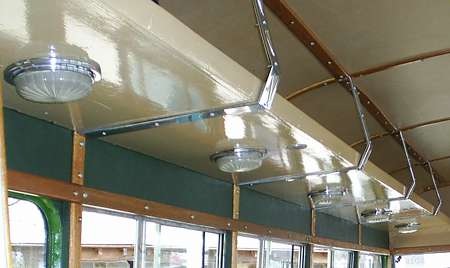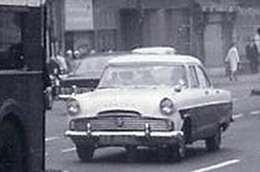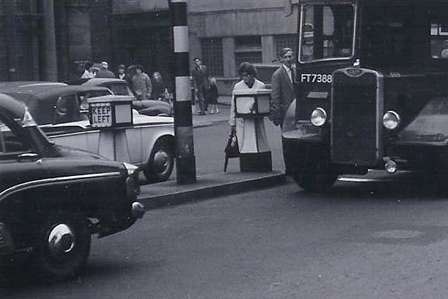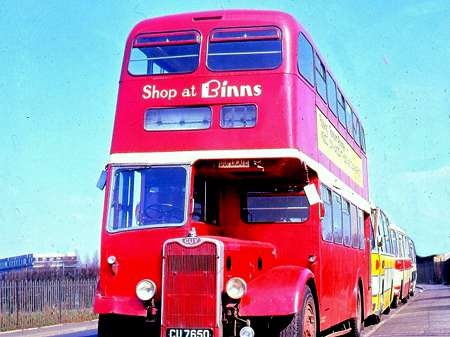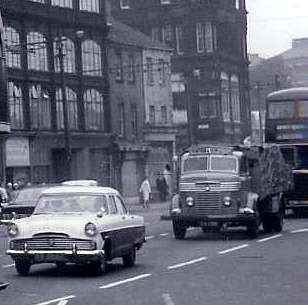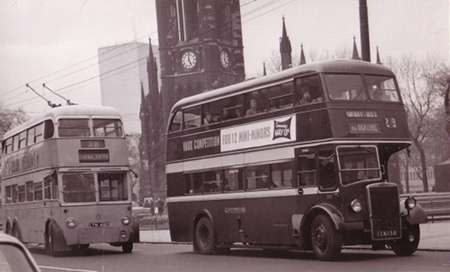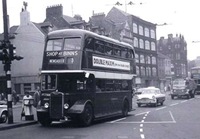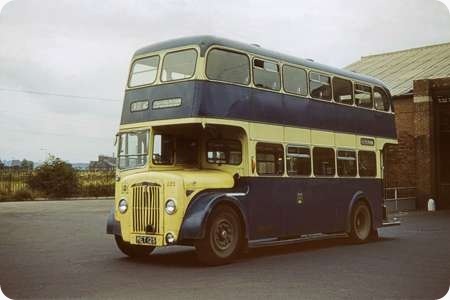Sheffield Corporation – AEC Regent I – BWE 526 – 208
Sheffield Corporation
1935
AEC Regent I
Weymann H56R
Another R H G Simpson photo which I think is worth sharing. Sheffield livery as you’ve never seen it before? Although many vehicles were taken into stock in 1935, this one was not part of a batch, and is possibly the only bus to appear this way in the fleet.
It would appear to be an attempt at streamlining, indeed the front seems to be raked back more than usual, that might just be an illusion caused by the livery application.
Photograph and Copy contributed by Les Dickinson
05/04/13 – 05:59
A similar AEC Regent also with Weymann body albeit fully fronted was exhibited at the 1935 show in Leeds livery. This was later converted to half cab and was lent to London in the second world war.
Chris Hough
05/04/13 – 05:59
This was one of a pair – the other for Leeds – with this streamlined design which were, I believe, also show exhibits. This Sheffield example, at least, was originally full fronted but Sheffield had it converted to half-cab for the obvious and usual access reasons before it entered service.
Weymann’s first double decker in 1931 was a demonstrator which became Sheffield No66 in 1932. 85 Regent/Weymann deckers followed until 1940 (208 a one off, the rest related to and culminating in the well known classic style). Apart from penny numbers from Park Royal, 10 Cravens and 19 from the Corporation Tramways works at Queens Road, all AEC Regents pre-war came from Addlestone. 197 post war Regent III and V came from Addlestone – along with 102 PD2s.
David Oldfield
05/04/13 – 09:01
…and then we complain about modern liveries! I suppose it was a one-off, but it does suggest that the continuing Hull livery came from another era.
Joe
05/04/13 – 15:34
Joe:
It certainly wasn’t a one-off. Manchester for a period went the same way, and the influence persisted in the standard liveries of Huddersfield Corporation and Rochdale.
In practice, we were very fond of swooshes back in the 1940s and 50s. Virtually every coach builder had their own pattern of shapes which allowed us to recognise whose body it was; of course in those days we simply called it ‘trim’. The ultimate development of livery application that bore no relationship to the lines of the body undoubtedly came from the Yeates works!
I think we can get too rose-tinted about the liveries of that era. Where I grew up as a child – north Somerset – buses all looked the same, and as we took early holidays down in Cornwall there was no difference there either. Nothing really to arouse the interest, so it wasn’t until many years later that I started to develop an interest. Even then – I had moved north by that time – there was Crosville on the doorstep . . .
I do feel that our affection for the old liveries is as much a longing for the variety of those years; the individual liveries were often themselves pretty boring – Liverpool, Manchester all red, London – but they did distinguish the operators from their neighbours. We used to admire those operators who took the trouble to continue to use a separate colour on the beading between the main colours, or apply the odd gold lining, but is this really any different from the way bits of colour are applied in today’s liveries?
A post elsewhere makes the point that today’s young people will doubtless grow up with the same attitude towards the style of today as we did 50 or so years ago.
Alan Murray-Rust
06/04/13 – 07:35
Perhaps "streamlining" was an attempt to bring the new science of lowered wind resistance from planes, cars and even trains…. to the appearance of buses. We even had streamlined buildings, looking like ships. The fifties brought a new functionalism, but this, as you say, was lost on some municipalities, so intent on making a swish transition from the front of the bus to the sides… but wavy lines? I suppose it’s all a bit dorsal fin: but in 1935 that was in the future with vinyl, half tones, ads covering up windows and route branding….. at least we don’t paint the doors in fluorescent colours (much- or only the drivers?) …yet: but wait till the helfansafety experts get there.
Joe
06/04/13 – 16:45
As well as the Weymann bodied "streamline" AEC Regent in Leeds colours with a livery application very like the Sheffield one but in dark blue and turquoise Leeds also had a Roe bodied "streamline" bus at the same show. This too was painted Blue and turquoise but looked very different to the Weymann example with an almost tear drop shape and very stylised appearance.
We forget today how big an impact the railways had on style at the time both LNER and LMS were starting to run streamlined locos like the Gresley Pacifics and such styling was common in both Europe and the USA.
Chris Hough
07/04/13 – 07:53
Like many of us, I also abhor the meaningless modern vinyl "imaging" on today’s buses and applaud the attempts by some 1930s operators and builders to try to make their buses look "modern". However, I can’t think of any instances where trams had these "go faster" liveries applied. Some, of course, didn’t need them as they were superbly designed to look modern (eg. Glasgow’s Coronations, Liverpool’s Green Goddesses, etc). The master of industrial design at this time was Raymond Loewy whose US company opened an office in London in the mid-30s. Did Weymann approach them I wonder?
Paul Haywood
07/04/13 – 07:55
Joe, OK they weren’t fluorescent but LT painted entrance doors on dual door buses yellow until late 80s(?), and in the run up to the formation of WYPTE Leeds painted Atlantean 447 and Swift 1065 in an experimental "Leeds District" livery incorporating yellow entrance doors and red exit doors.
The 30s streamlined liveries may not always have fitted the lives of the buses to which they were applied – but what I think makes them forgivable is that they were identifiably local/distinct, and they used strong/bold/deep colours unlike the flat and/or wishy-washy pastels used by two of the big groups today. But, picking-up on a point Alan made, I’ll stick my neck out and say that gold lining-out was just too fussy once rocker-panels had ceased to be a feature of bodywork.
Philip Rushworth
07/04/13 – 07:56
Joe Although not florescent London Transport painted entrance doors yellow for many years.
Chris Hough
07/04/13 – 09:52
Paul, I know I’m biased, but for me the mention of ‘modern-looking’ trams really has to start with the Sheffield Roberts ones.
Les Dickinson
07/04/13 – 16:54
Point taken, Les – yes, the Sheffield Roberts cars were smart indeed and I enjoyed riding on them in their final years, but for me, being four-wheelers, they lacked the majesty of the streamlined bogie cars. The whole 1930s period (before my time) fascinates me. For many, the sight of a streamlined tram or bus, or a visit to an art deco cinema, represented a vision of the future. We’ve all seen those early artists impressions of "How we will be living in twenty years" etc. where travel by monorail, gyrocopters and airships was assumed. When this bus was built, those visions would still be valid. The quest for increased speed on land, sea and air influenced designers throughout this period and this bus is a wonderful example.
Paul Haywood
07/04/13 – 16:54
I personally like the look of this bus. Did you notice the wind down windows. I only noticed these on a few Weymann AECs, (which also had a "booming" exhaust) on the 101 Arbourthorne route, climbing the very steep hill up East Bank Road, & some PD2s on the 69 route to Rotherham. The PD2s also had a complete destination & route number in the same big oblong route destination board. I have seen similar on other companies buses. They may be pre 1950s, with all Leyland bodies.
Andy Fisher
08/04/13 – 15:20
Andy, the PD2’s with the one destination box for route number and destination were the three so-called ‘stock sale’ PD2’s, that Leyland built on spec. for quick delivery to operators willing to forego their regular requirements such as standardized destination layouts in order to obtain buses quickly. The three that Sheffield managed to get, 601-3 (LWB 301-3), were put to work on the 69 service to Rotherham when it was decided not to relay the tramlines on the new road bridge at Tinsley, and thus abandoning for good the Sheffield-Rotherham tram service. The Sheffield trams ran no further than Vulcan Road after that, while the Rotherham single-enders ran only to Templeborough, and even they finished six months later, in November 1949.
City, Sheffield, Templeborough and Rotherham, with the applicable route numbers, were, I think, the only destinations that the trio had on their blinds, so they were more or less route-bound to the 69 or the 169 to Templeborough. A friend has told me that apparently one of them quite often showed up to run a ‘cinema-extra’ to Nether Edge late of an evening, when the picture houses were turning out (before the days of television!) before running into the garage after working on the 69 all day, but just what it showed on the blind I’m not certain. I’ve got a photo of one of them on a stand in Castlegate showing just ‘City’ in big letters, but I don’t know what route is would have been on.
Dave Careless
09/04/13 – 06:41
And while we’re on the theme of streamlining in the 1930’s, let’s not forget those Flying Bananas on the Great Western Railway. For a railway that remained strongly wedded to steam traction, this batch of AEC (and later BUT) engined diesel railbuses had a charm and character all of their own.
I know this is a bus blog, but I’m sorry, I couldn’t help myself from eulogising about these splendid rail buses !
Petras409
14/05/13 – 07:57
Andy. Only the first post war Regent III/Weymanns (527 – 536) had half drop windows. The others (1947/8) had sliders.
Petras409. Strictly speaking, DMUs had underframes built by BUT with engines supplied by either AEC or Leyland – and in a minority of cases Rolls Royce.
David Oldfield
14/05/13 – 17:22
BUT (British United Traction) was a joint sales organisation set up by AEC and Leyland for the purpose of supplying railway and trolleybus equipment, in order to give the companies a more realistic presence in what were quite limited markets. It was a similar arrangement to that of MCW, formed by the one-time totally independent companies of Metro-Cammell and Weymann.
As far as railway equipment goes, the BUT contribution was almost invariably engines and transmissions – but these were always proprietary (or suitably modified proprietary) items, BUT never having had any manufacturing plants. The engines supplied (for use in DMUs and railbuses) were manufactured by AEC, Leyland, or (in at least one instance) Albion – itself owned by Leyland at the time.
The exception to the above appears to concern early DMUs 79740-50, given as of BUT manufacture. If this is correct, the underframes and bodies must have been built somewhere (there were several likely locations within the Leyland or ACV – parent of AEC – groups). Oddly, Park Royal (itself part of ACV) supplied the bodies for some DMUs and railbuses, apparently independently of BUT.
As for Rolls-Royce engined DMUs, it may be that BUT was given the task of supplying the entire driveline and itself sourced the engines from Rolls-Royce – this is the impression given by the wording of current internet descriptions of the various DMU classes.
The supply of trolleybus chassis by BUT effectively continued the erstwhile AEC range, and trolleybus chassis building at Leyland was dropped.
As BUT was created in 1946, and the last GWR railbuses were constructed in 1942, it could not be said that there was any BUT input to the latter. The original engines were definitely of AEC manufacture, but replacement engines fitted later may well have been considered to be BUT, rather than AEC, products, of course.
David Call
19/05/13 – 15:28
Thanks for the update on the windows & route box. I am just an observer, not really knowledgeable. Now I have taken much more interest in researching Sheffield buses, I do appreciate your knowledge on these matters. You may find some of my comments a bit silly, but it is my lack of knowledge. I also do not come online that often, so you may not get an immediate thanks from me.
Andy Fisher
21/05/13 – 15:01
Following on from your information, I had a look in my tram book. The last tram from Sheffield to Rotherham was in 1948 , so presumably, these PD2s must have been of 1948 vintage. There was another PD2 all Leyland in the book, on another route. It had normal layout destination board, but with opening front upstairs windows. Can any of you people identify it for me please? I must confess to being an AEC fan, Leylands were not local untill the 1960 tram replacement tin fronts. That is unless we visited my auntie at Southy Green. The 97 & 98. They were also all Leylands. One had rounded ended opening lights, with interior lights covered in round, fluted lightshades, really smart. The other route was standard PD2s all Leyland design. They must have been 1940s buses, as it never was a tram route, so must have always been serviced by buses. I think the estate was built just after the war. Any help in identifying these busses would be appreciated.
Andy Fisher
22/05/13 – 07:21
The PD2s with opening windows would have been 656 – 667 – 1952 all Leyland PD2/10s. The three odd PD2s were indeed 1948 and doubly strange for being standard Leyland bodies in among Faringtons.
David Oldfield
24/05/13 – 14:04
Andy Fisher – regarding the smart interior lights with round fluted covers, I assume you mean like this – in this instance fitted in the preserved Crosville AEC Regal with Strachans body (seen here at the 2010 Kingsbridge running day). This sort of light fitting was also virtually universal on Trent’s many Willowbrook bodied double deckers.
Stephen Ford
25/05/13 – 08:26
In the main the engines supplied by BUT to power BR’s DMUs were horizontal versions of the AEC A221 of 11.3 litres or the Leyland 0680 of 11.1 litres. The transmission consisted of a fluid flywheel and a four speed Wilson epicyclic gearbox. These were very much ‘bus engineering’.
It’s not true to say that the formation of BUT as a marketing organisation for trolleybuses saw the end of Leyland based trolleybuses. Whilst the majority of home market trolleybuses were based on AEC designs that were closely allied to the contemporary Regent bus chassis (the six wheel BUT used the front end of the Regent Three in conjunction with an updated version of rear end of the pre-war 664T), Glasgow did receive single deck trolleybuses based on, I believe, the Royal Tiger chassis or its Worldmaster equivalent.
Michael Elliott
25/05/13 – 17:15
Thanks for the info guys. Yes Stephen those lightshades were indeed the ones I remember.
Andrew Fisher
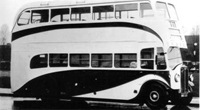 Vehicle reminder shot for this posting
Vehicle reminder shot for this posting
13/10/15 – 06:11
With regard to the Petre Street routes 34 and 35, these originally were Nos. 17 and 10 just post war. Incidentally, Petre Street was/is pronounced ‘Peter’ by locals ! ‘Hunsley Street’was also featured on the destinations. The terminus at the Wesleyan Chapel was of interest due to the alleyway by the side of the stop having an ancient water pump on it, painted green if memory serves me right. The tramway these routes replaced terminated at Petre St./Carwood Road, around half a mile or so before the Wesleyan Chapel bus terminus. There was a fatal accident outside the Ellesmere Road school in the 50’s when a man threw himself under a city bound Regent III (I seem to remember that it was 567 ?)
Mike C
Quick links to the - Comments Page - Contact Page - Home Page

